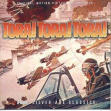
|
“TORA! TORA! TORA!”
Time Magazine, October 5, 1970
“The first half of the film is devoted to apple-pie softness and bamboo resilience. In war movies of the ‘40s, the Japanese were a thin yellow line. Tora! Tora! Tora! is a refreshing reversal...It is the Orientals who are individuals...No single man can be blamed, and no villains or heroes emerge from this foundering, slipshod -- and hypnotic -- drama. That judgment must hold not only for those who lived it but also for those who filmed it. Three directors, one American (Richard Fleischer) and two Japanese, Toshio Masuda and Kinji Fukasaku, have managed to move crowds and planes, but not the viewer...Original, Master Director Akiro Kurosawa (Rashomon) was signed to oversee the Japanese sequences. He might have revealed the complex psychologies that led to the abyss and beyond. Without him, the film is a series of episodes, a day in the death. As for real men and causes, they are victims missing in action.”
Newsweek, September 28, 1970
“Twentieth Century-Fox’s lavish re-creation of the Japanese attack on Pearl Harbor and the events that led to it, is put together like a Fourth of July celebration -- a long procession of predictable speeches leading to a spectacular fireworks display...The Japanese episodes (orignally assigned to the great Akira Kurosawa who was later dropped) were seperately filmed in Japan by two Japanese directors, Toshio Masuda and Kinji Fukasaku. They carry a good deal more spirit and imagination than the American episodes. In these there are no perfromances, only dramatic readings...”
“...it presents as stomach-wrenching and dazzling a cavalcade of action footage as has ever been put on the screen. One feels exactly what it is like to be blasted from the deck of a torpoed ship.”
“The aerial photography rivals ballet in the grace of its elegant choreography. The pathetic scenes of American planes blasted to oblivion while attempting take off explain in their violence and uncompromising realism how two men died in the making of the film.”
New York Times, September 25, 1970
“As history, it seems a fairly accurate account of what happened, although it never much bothers its head about why. As film art it is nothing less than a $25-million irrelevancy. As entertainment -- well, that depends on your tolerance for history presented mostly as series of tableaux vivants et parlants, set in conference rooms, code rooms and antechambers and involving such dynamic personages as Cordell Hull, Henry Stimson and Frank Knox (for our side) and Admiral Yamamoto, Ambassador Nomura and General Tojo (for theirs).
“Tora! Tora! Tora! aspires to dramatize history in terms of event rather than people and it just may be that there is more of what Pearl Harbor was all about in fiction films such as Fred Zinneman’s “From Here to Eternity” and as the Variety review pointed out, Raoul Walsh’s “The Revolt of Mamie Stover” than in all of the extravagant posturing in this sort of historical mock-up.”
The Hawaii Times (Japanese newspaper), September 24, 1970
“The Tokyo showing of the $25 million film -- “Tora! Tora! Tora!” -- drew applause from the largely Japanese audience at the close of the show. The speculation centered on the effect it might have on young Japanese who know Pearl Harbor only as the first step in the defeat of World War II. One of those who believed it would have an anti-war impact was Mrs. Alice Kurusu, American-born widow of Saburo Kurusu, Japan’s Ambassador to Washington at the time of Pearl Harbor...The white haired Mrs. Kurusu told the Associated Press afterward the movie was “absolutely splendid,” then added “Showing it in Japan will be a good thing for the young Japanesewho don’t know what war is like. It will teach them to be cautious about getting involved in such disasters in future.”
“The film which shows Japanese planning and execution of the attack as virtually flawless in contrast to American bumbling and lack of preperation, may well strike some secret sparks of pride among the middle-aged Japanese who were here when it happened.”
|


